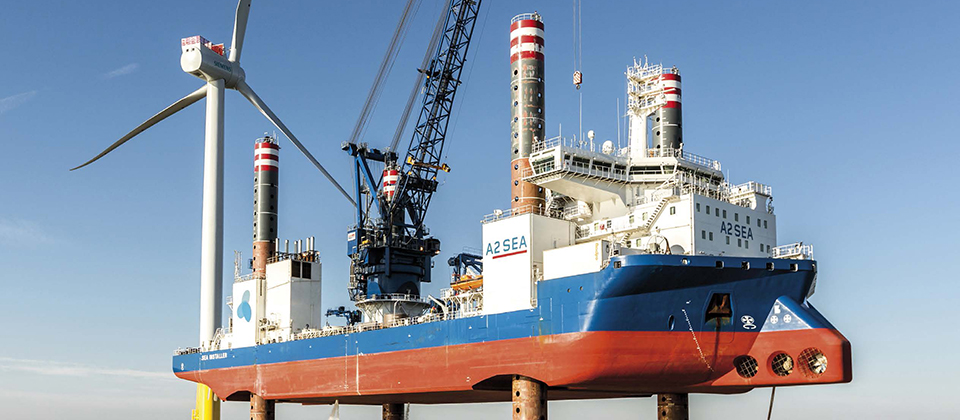
Recent turbulence has left the German market a mixed bag for supply chain participants and investors. However, with the first major project successfully completed and more on the way, the general atmosphere is quickly becoming more positive. TurbineInstaller reviews the current state of offshore wind in German waters.
Mixed feelings
It’s hardly a secret that the German market has faced some challenges within the offshore wind sector. Political changes and grid infrastructure issues have postponed what has long promised to be an enormous potential. And the previous target of 10 GW of offshore wind by 2020 has been reset at 6.5 GW. While some suppliers raised red flags in concern at the scale-down, turbine manufacturers and utilities have welcomed the target as being a more realistic aim for what can be constructed offshore in the period leading up to 2020. So is it time for a new look at Germany? Are there, in fact, grounds for cautious optimism?
Hope on the horizon
In a market often characterised by clouds on the horizon, there are now bright signs of success that point the way towards new strength. In April this year, WindMW GmbH, a joint venture between Blackstone Energy Partners and and Windland Energieerzeugungs GmbH, announced the completion of Meerwind Süd & Ost, a 288 MW offshore wind farm located in the German North Sea. After 18 months of construction, and some EUR 1.2 billion in funding, the last of 80 turbines was successfully installed, along with the installation of the site’s 3,500-tonne offshore converter substation.
Other projects are waiting in the wings, too. By mid-2015 too, Butendiek offshore wind farm, developed by wpd offshore solutions, is expected to swing its 288 MW Siemens 3.6 MW turbines into action, powering some 360,000 households. And DONG Energy’s huge Gode Wind 1 and 2 projects will soon add serious power to the existing line-up.
Such projects could be expected to function as showcase examples of what is possible even under difficult conditions. And they demonstrate continued optimism in the region, indicating that, one step at a time, all will be well.
Proceed with care
Of course, one would be wise not to paint too rosy a picture of things. In early 2014, WindMW was forced to pull out of its plans for the 64-turbine, 320MW Nördlicher Grund offshore wind farm, which should have begun construction in September this year. Lack of clarity over the timing of the SylWin 2 export cable and convertor station installation, as well as an uncertain business case resulting from political delays in determining the “basic economic conditions” had long been casting a shadow over the project. The final verdict came when Germany’s offshore network plans determined a 2023 installation date for SylWin 2, removing all rationale for what was otherwise a promising development. In all, costs ran to several million Euros for the failed venture.
There are other issues, too, that are particular to the German market. For example, the Riffgat wind farm in the German North Sea, due to be completed last July, was delayed seven months after the discovery of a large number of unexploded bombs.
And of course, onshore grid development, a high-profile stumbling block, still lags behind. Dutch-owned transmission system operator (TSO) Tennet has, however, committed to installing offshore substations, complete with the ability to connect other wind farms as they appear. It’s perhaps reasonable to expect that other favourable winds could blow here, too, with growing political and investor will to remove barriers to a sustainable energy future.
Back on the agenda
Summoning support for offshore wind’s business case in the region, German politicians have now extended the offshore wind feed-in tariff until 2019, although simultaneously speeding up the rate of decline in the tariff. This is a positive signal to developers and investors that they have an extended period to realise their projects.
In the light of this renewed support, Lars Thaaning Pedersen, Senior Vice President at DONG Energy, clearly expresses his company’s confidence in the market to A2SEA News: “The German offshore wind market has strong potential and is one of the reasons why we consider Germany as a core market for us, and the reason why we are already constructing the offshore wind farms Borkum Riffgrund 1 and Gode Wind 1 + 2 and have even more German projects in our pipeline. The decision to prolong the support for offshore wind energy in 2018 and 2019 shows the commitment from the German government towards offshore wind.”While offshore wind may be back on the agenda for Germany’s politicians, there’s still some way to go before more private equity and similar funds, as well as industrial companies, really get the ball rolling. Blackstone Energy Partners’ leadership in this respect is, perhaps, worth watching, given the firm’s impressive track record of timely investments in the past.
Full steam ahead for A2SEA
For A2SEA, it’s full steam ahead in Germany. At Borkum Riffgrund 1, during June, the first cables will be rolled out by CT Offshore as part of its scope. And in July, SEA INSTALLER begins wind turbine installation at the site. Then, in 2015, at Gode Wind 1 and 2, SEA INSTALLER will install all 97 turbines. Finally, in 2016, cabling will be installed and buried at Gode Wind 1 and 2, ready for commissioning in the second half of the year. Both projects are owned by DONG Energy.
Moving forward
At the end of the day, well-planned, well-executed projects will win through. That’s the new reality behind the confidence now being demonstrated by developers and investors alike in the future of German offshore wind.
Wind farm facts
MEERWIND SÜD & OST
With 288 MW of capacity, and located 23km north of Helgoland, this project comprises two wind farms – Meerwind Süd and Meerwind Ost – now providing power for around 360,000 households. It is the first German offshore wind project to be fully financed by private investors.
BORKUM RIFFGRUND 1 WIND FARM
Borkum Riffgrund 1 will have a capacity of up to 312 MW, and is located around 37km from the north-west coast of Germany, near the island of Borkum. Construction started in 2013, and the wind farm will be commissioned during 2014. The wind farm is jointly owned by DONG Energy, Kirkbi A/S and William Demand Holding A/S.
GODE WIND 1 AND 2
DONG Energy’s Gode Wind 1 and 2 project is its largest-ever investment, and will feature 97 Siemens 6 MW turbines. When completed, with 582 MW of power, Gode Wind 1 and 2 will be the largest contiguous offshore wind farm in Germany to date.
Like this post? Subscribe now and get notified about new content!
